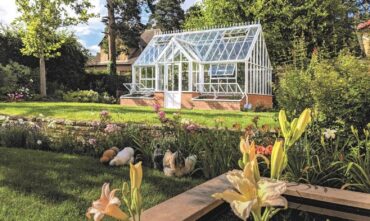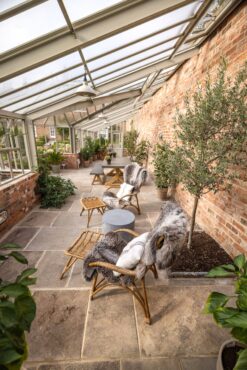
Hartley Botanic is an English, luxury glasshouse manufacturer whose beautiful, handmade glasshouses and greenhouses are now available to US customers. The company’s experts have provided WestSound Home & Garden with their top tips on how you can best style, organize and refresh your own greenhouses for spring – to truly enjoy their potential.
Create a ‘Lifestyle’ Area
A glasshouse can be used as a multi-functional space, allowing you to stay outdoors and among your plants longer — whether that’s enjoying a cup of tea while listening to the rain patter against the roof, or making use of it as an al fresco space in the warmer summer months.
There are many stylish ways to extend time spent in your glasshouse or greenhouse. Use internal partitions to separate growing areas from spaces you can use for relaxing. Think about the activities you could do to make the best use of any lifestyle space, whether dressing a table for al fresco entertaining, pursuing a hobby like painting or just creating a new “under glass” area to enjoy with friends. Introducing home conveniences, such as an eco-wood burner, is also great way to warm spring and autumn evenings and provide an additional heat source for tender plants.
Invest in Beautiful Organizational Accessories
There are many organizational accessories that can help you make the best use of your glasshouse space inside, using a mix of shelving, staging and partitions — these also have the benefit of looking very attractive. (As an example, see Hartley Botanic’s aluminum staging options, including ornate designs, which can be powder-coated in a desired color).
Staging: To grow and appreciate most greenhouse plants, they need to be displayed on staging, set at around table height. Pots can be stood on these tables, or alternatively shallow trays can be filled with a layer of grit or gravel can be used — if you keep it moist, you can maintain a more plant-friendly habitat. Gravel trays can be used in automated watering systems, reducing the rate at which pots dry out in summer.
Shelves: Shelves make more efficient use of space by occupying higher parts of your greenhouse. This is particularly useful for trailing and smaller plants. Shelving also improves the appearance and visual impact of the greenhouse by creating elevated displays of ornamental plants.
Potting bench and compost store: You may wish to consider setting aside an area of staging for a potting bench, or to store items of equipment or compost in a waterproof locker or cupboard beneath to help keep the glasshouse tidy.
Partitions: Partitions, which are internal glass walls, could also be used in the layout to provide a stylish way to separate your greenhouse into different zones. They will also allow you to create variations in climate for different plant groupings more easily.

Create Different Growing Zones
The layout of plants within a glasshouse or greenhouse can be organized so as to provide optimum growing conditions, at the same time as allowing gardeners to get maximum benefit and enjoyment.
Using different levels of shelving works well both practically and visually. Lower benches are useful for plants that are “resting,” such as corms like Cyclamen and tubers like Achimenes (hot water plants.) Top shelf staging is ideal for orchids, as this can mimic their natural environment well, since they grow in trees.
Integrated aluminum cold-frames and growing beds provide further flexibility to develop separate growing conditions for different plant types. Cold-frames can also provide the perfect interim environment for efficient “hardening off” greenhouse-grown plants.
If you plan to grow food crops, cut flowers or anything else in quantity, you will probably want to set up some beds. A greenhouse built on a brick foundation, with natural soil as its floor, will have the advantage of ready-made growing facilities that can be incorporated at the installation stage. If the building rests on a concrete base, raised beds can be built or growing bags used for crops and plants.
Fill Your Glasshouse with Scent
Many fragrant herbs can be easily grown in a greenhouse, which adds a special sensory dimension. Lavender to help you relax and sleep. Camomile for anti-anxiety or echinacea to boost the immune system. Growing herbs is also a great way to take advantage of the glasshouse all year round, and especially as a shelter from the winter frost.
Herbs that are popularly used in cooking, such as thyme, often have varieties from warmer climates such as the Mediterranean, which means they suit a greenhouse well as they are not completely hardy. Many herbs are ideal for growing in containers and can be kept by the door of your greenhouse for ease of picking and so you can appreciate the scent they release when touched.
Give Your Glasshouse a Thorough ‘Spring Clean’
There are five key jobs to do when it comes to spring-cleaning your glasshouse:
- Clean frame and glass – both inside and outside.
- Clean and disinfect the interior — including all benches, shelves and equipment.
- Check and clean out gutters and down pipes.
- Clean the floor.
- Check the operation of vents.
Clean the windows of your greenhouse inside and out, as well as its doors and partitions (if you have them), not forgetting to pay attention to the individual frames and surrounds. Keep in mind that some greenhouses, such as those offered by Hartley Botanic, don’t require a special cleaning solution. Instead, the glass and aluminum can be easily cleaned with hot water and a diluted household detergent, rinsing the glass with distilled water to reduce smears. A flexible scraper such as a plastic plant label is handy to remove any dirt build-up around the edge of windows.
Ensure your gutters are clear of leaves and clean down the pipes. Scoop leaves out with your hands and flush debris away with a hosepipe or watering can. While protecting and removing any delicate plants, clean the floor of your greenhouse and disinfect all benches, shelving and equipment — this will help to control pests and diseases. Warm, soapy water and a sponge work best when cleaning blinds, but make sure they are in-situ while you clean. Otherwise, you may struggle to refit them — and they will dry quicker while extended in the greenhouse. Lastly, check the operation of your roof and side vents so they are ready for use in the coming spring and summer months.




























Comments